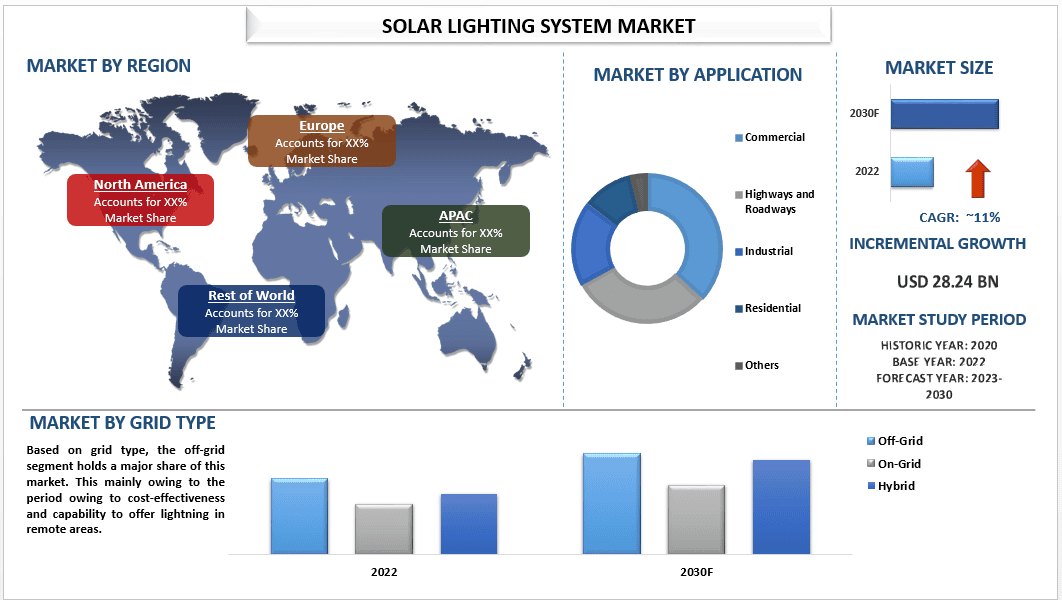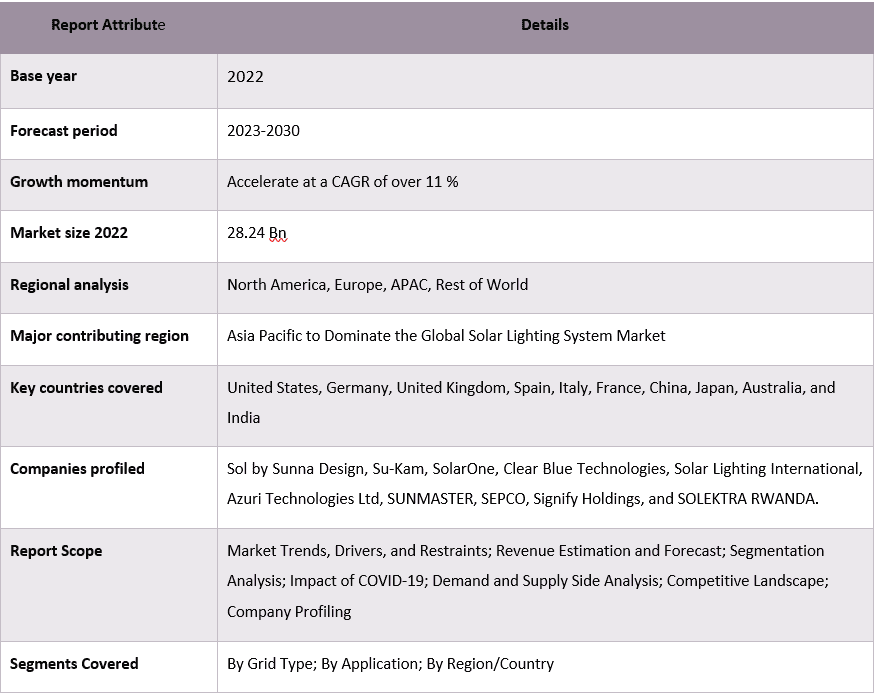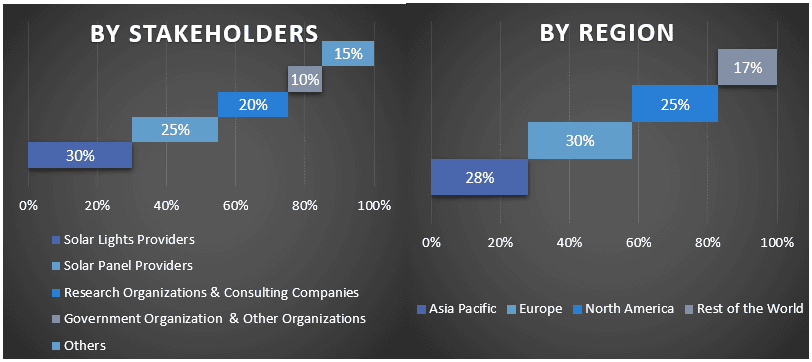- الرئيسية
- معلومات عنا
- صناعة
- الخدمات
- قراءة
- اتصل بنا
سوق أنظمة الإضاءة الشمسية: التحليل الحالي والتوقعات (2023-2030)
التركيز على نوع الشبكة (خارج الشبكة، وعلى الشبكة، والهجينة)؛ والتطبيق (تجاري، والطرق السريعة والطرق، وسكني، وصناعي، وغيرها)؛ والمنطقة/الدولة

من المتوقع أن ينمو سوق أنظمة الإضاءة الشمسية العالمي بمعدل كبير يبلغ حوالي 11٪ خلال الفترة المتوقعة. عوامل مثل زيادة المبادرات والإعانات الحكومية، وتوفير الكهرباء للمواقع النائية، وزيادة استخدام الطاقة الشمسية هي عوامل محفزة للنمو. يساهم اللاعبون الرئيسيون في مجالات الطاقة والتكنولوجيا والشركات الناشئة والمبتكرون بنشاط في تطوير واعتماد نظام الإضاءة الشمسية.
على سبيل المثال: في مايو 2022، أعلنت شركة Lord's Marks industries أنها فازت بعقد من حكومة بيهار الهندية لتصميم أكبر مشروع إضاءة يعمل بالطاقة الشمسية في العالم في جميع أنحاء الولاية.
على سبيل المثال: في يناير 2020، أعلنت شركة SolarOne Solutions, Inc. أنه تم اختيارها من قبل المركز المجتمعي Eagle Butte لتوفير وتركيب مصابيح الشوارع الشمسية خارج الشبكة بهدف تقليل البصمة الكربونية.
تعتبر SEPCO و Clear Blue Technologies و Signify Holding و Sol by Sunna Design و Su-kam و SolarOne و Azuri Technologies Ltd و Solar Lighting International و SUNMASTER و SOLEKTRA RWANDA من بين اللاعبين الرئيسيين في السوق. وقد قامت هذه الشركات بالعديد من عمليات الاندماج والاستحواذ بالإضافة إلى الشراكات لتزويد العملاء بمنتجات/تقنيات مبتكرة وعالية التقنية.
الرؤى المقدمة في التقرير
"من بين أنواع الشبكات، من المتوقع أن تشهد فئة خارج الشبكة معدل نمو سنوي مركب أعلى خلال الفترة المتوقعة."
استنادًا إلى نوع الشبكة، تأتي المصابيح الشمسية بأنواع مختلفة من توصيلات الشبكة. ومع ذلك، من المتوقع أن تستحوذ أنظمة الإضاءة خارج الشبكة على الحصة السوقية الأكبر في الفترة المتوقعة، نظرًا لاعتمادها على نطاق أوسع في البلدان النامية لأن تركيب هذه المصابيح أرخص ولا يتطلب أي بنية تحتية للكابلات، والقدرة على توفير الإضاءة حتى في المناطق النائية حيث لا توجد شبكة أو شبكة غير موثوقة. علاوة على ذلك، تقدم الشركات خيارات دفع مربحة لزيادة اعتماد المصابيح الشمسية في المناطق الريفية.
من ناحية أخرى، تستهلك المصابيح الشمسية الهجينة في حالة عدم وجود طاقة شمسية الكهرباء مباشرة من الشبكة، وبالتالي توفر كهرباء أكثر موثوقية وتشغيلية. وبالمقارنة، تستخدم الإضاءة الشمسية المتصلة بالشبكة الألواح الشمسية لتوليد الكهرباء التي يتم تغذيتها مباشرة إلى شبكة الطاقة المحلية. يعتمد هذا النظام على البنية التحتية للشبكة الحالية لتخزين الطاقة وتوزيعها.
على سبيل المثال: وفقًا لتقرير السوق العالمي للطاقة الشمسية خارج الشبكة الصادر عن GOGLA، في عام 2020، تم بيع ما مجموعه 3.6 مليون منتج إضاءة شمسية خارج الشبكة، منها 2.41 مليون منتج تم بيعها كمنتجات نقدية، وتم بيع باقي المنتجات البالغ عددها 1.19 مليون من خلال نموذج PayGo.
"من بين التطبيقات، من المتوقع أن تستحوذ الشريحة التجارية على حصة كبيرة في السوق في عام 2022."
يتكون سوق أنظمة الإضاءة الشمسية من خمس شرائح: تجارية وصناعية وسكنية وطرق سريعة وطرق وتطبيقات أخرى. تستحوذ الشريحة التجارية على حصة كبيرة من هذا السوق. ويعزى ذلك بشكل أساسي إلى الاعتماد الأوسع لهذه المصابيح المثبتة في المدارس والمكاتب المؤسسية والجامعات. علاوة على ذلك، تستخدم الشريحة التجارية المصابيح الشمسية الخارجية والداخلية لإضاءة الطوابق السفلية والممرات والأقبية وما إلى ذلك. يساعد تركيب المصابيح الشمسية في المناطق التجارية على تقليل تكاليف الطاقة والصيانة.
علاوة على ذلك، من المتوقع أيضًا أن ينمو القطاع السكني بشكل كبير بسبب زيادة اعتماد أنظمة الإضاءة الشمسية في البلدان النامية، وخاصة في إفريقيا ومنطقة آسيا والمحيط الهادئ، لتقليل فواتير الكهرباء في الدول المتقدمة وتقليل تكاليف أنظمة الإضاءة الشمسية.
على سبيل المثال: وفقًا لتقرير البنك الدولي، ارتفع عدد الأشخاص الذين يحصلون على مجموعات الطاقة الشمسية من 420 مليون شخص في عام 2019 إلى أكثر من 490 مليون شخص بحلول نهاية عام 2021، مع حصول المزيد من الأشخاص على مستويات أعلى من "المستوى 2".
تغطية تقرير سوق أنظمة الإضاءة الشمسية

"من المتوقع أن تستحوذ منطقة آسيا والمحيط الهادئ على حصة كبيرة في السوق."
من المتوقع أن تشهد منطقة آسيا والمحيط الهادئ معدل نمو كبير في الفترة المتوقعة. العامل الأساسي الذي يدفع هذا النمو هو المبادرات الحكومية المتزايدة نحو المصادر المتجددة والطاقة النظيفة، إلى جانب دول مثل الصين واليابان والهند وأستراليا، التي تستثمر بنشاط في الطاقة الشمسية، مما يؤدي إلى زيادة في اعتماد أنظمة الإضاءة الشمسية. علاوة على ذلك، فإن اعتماد الإضاءة الشمسية في منطقة آسيا والمحيط الهادئ هو الحاجة إلى توفير الكهرباء للمناطق الريفية. تحتاج العديد من المناطق النائية والريفية في دول مثل الهند وإندونيسيا والفلبين إلى الوصول إلى كهرباء موثوقة. توفر هذه الأنظمة مصدرًا مستدامًا وبأسعار معقولة للكهرباء. علاوة على ذلك، لعبت الشعبية المتزايدة للمصابيح الشمسية خارج الشبكة أيضًا دورًا أساسيًا في دفع سوق أنظمة الإضاءة الشمسية. نظرًا لسهولة تركيبها وفعالية تكلفتها، أصبحت المصابيح الشمسية خارج الشبكة شائعة لإضاءة المواقع النائية والشوارع والأماكن العامة في جميع أنحاء آسيا.
أسباب شراء هذا التقرير:
- تتضمن الدراسة تحليل تقدير حجم السوق والتنبؤ به والذي تم التحقق منه من قبل خبراء الصناعة الرئيسيين المعتمدين.
- يقدم التقرير مراجعة سريعة للأداء العام للصناعة في لمحة.
- يغطي التقرير تحليلًا متعمقًا لأقران الصناعة البارزين مع التركيز الأساسي على البيانات المالية التجارية الرئيسية ومجموعة المنتجات واستراتيجيات التوسع والتطورات الحديثة.
- فحص تفصيلي للدوافع والقيود والاتجاهات الرئيسية والفرص السائدة في الصناعة.
- تغطي الدراسة السوق بشكل شامل عبر قطاعات مختلفة.
- تحليل متعمق على المستوى الإقليمي للصناعة.
خيارات التخصيص:
يمكن تخصيص سوق أنظمة الإضاءة الشمسية العالمي بشكل أكبر وفقًا للمتطلبات أو أي شريحة سوقية أخرى. إلى جانب ذلك، تتفهم UMI أن لديك احتياجات عمل خاصة بك، لذا لا تتردد في التواصل معنا للحصول على تقرير يناسب متطلباتك تمامًا.
جدول المحتويات
منهجية البحث لتحليل سوق أنظمة الإضاءة الشمسية (2023-2030)
كان تحليل السوق التاريخي وتقدير السوق الحالي والتنبؤ بالسوق المستقبلي لسوق أنظمة الإضاءة الشمسية العالمي هي الخطوات الرئيسية الثلاث التي تم اتخاذها لإنشاء وتحليل اعتماد أنظمة الإضاءة الشمسية في المناطق الرئيسية على مستوى العالم. تم إجراء بحث ثانوي شامل لجمع أرقام السوق التاريخية وتقدير حجم السوق الحالي. ثانيًا، للتحقق من صحة هذه الرؤى، تم أخذ العديد من النتائج والافتراضات في الاعتبار. علاوة على ذلك، تم أيضًا إجراء مقابلات أولية شاملة مع خبراء الصناعة عبر سلسلة القيمة لسوق أنظمة الإضاءة الشمسية العالمي. بعد الافتراض والتحقق من صحة أرقام السوق من خلال المقابلات الأولية، استخدمنا نهجًا من أعلى إلى أسفل/من أسفل إلى أعلى للتنبؤ بحجم السوق الكامل. بعد ذلك، تم اعتماد طرق تقسيم السوق وتثليث البيانات لتقدير وتحليل حجم سوق القطاعات والقطاعات الفرعية للصناعة ذات الصلة. المنهجية التفصيلية موضحة أدناه:
تحليل حجم السوق التاريخي
الخطوة 1: دراسة متعمقة للمصادر الثانوية:
تم إجراء دراسة ثانوية مفصلة للحصول على حجم السوق التاريخي لسوق أنظمة الإضاءة الشمسية من خلال مصادر الشركة الداخلية مثل التقارير السنوية والبيانات المالية وعروض الأداء والنشرات الصحفية وما إلى ذلك، والمصادر الخارجية بما في ذلك المجلات والأخبار والمقالات والمنشورات الحكومية ومنشورات المنافسين وتقارير القطاعات وقاعدة بيانات الطرف الثالث والمنشورات الموثوقة الأخرى.
الخطوة 2: تقسيم السوق:
بعد الحصول على حجم السوق التاريخي لسوق أنظمة الإضاءة الشمسية، أجرينا تحليلًا ثانويًا مفصلاً لجمع رؤى السوق التاريخية وحصتها للقطاعات والقطاعات الفرعية المختلفة للمناطق الرئيسية. يتم تضمين القطاعات الرئيسية في التقرير كنوع وعملية. علاوة على ذلك، تم إجراء تحليلات على مستوى الدولة لتقييم الاعتماد العام لنماذج الاختبار في تلك المنطقة.
الخطوة 3: تحليل العوامل:
بعد الحصول على حجم السوق التاريخي للقطاعات والقطاعات الفرعية المختلفة، أجرينا تحليلًا تفصيليًا للعوامل لتقدير حجم السوق الحالي لسوق أنظمة الإضاءة الشمسية. علاوة على ذلك، أجرينا تحليلًا للعوامل باستخدام متغيرات تابعة ومستقلة مثل نوع وعملية أنظمة الإضاءة الشمسية. تم إجراء تحليل شامل لسيناريوهات جانب الطلب والعرض مع الأخذ في الاعتبار أهم الشراكات وعمليات الاندماج والاستحواذ والتوسع التجاري وإطلاق المنتجات في قطاع سوق أنظمة الإضاءة الشمسية في جميع أنحاء العالم.
تقدير حجم السوق الحالي والتوقعات
تحديد حجم السوق الحالي: بناءً على رؤى قابلة للتنفيذ من الخطوات الثلاث المذكورة أعلاه، توصلنا إلى حجم السوق الحالي واللاعبين الرئيسيين في سوق أنظمة الإضاءة الشمسية العالمي والحصص السوقية للقطاعات. تم تحديد جميع الحصص المئوية المطلوبة والتقسيمات وتوزيعات السوق باستخدام النهج الثانوي المذكور أعلاه وتم التحقق منها من خلال المقابلات الأولية.
التقدير والتنبؤ: لتقدير السوق والتنبؤ به، تم تخصيص أوزان لعوامل مختلفة بما في ذلك المحركات والاتجاهات والقيود والفرص المتاحة لأصحاب المصلحة. بعد تحليل هذه العوامل، تم تطبيق تقنيات التنبؤ ذات الصلة، أي النهج من أعلى إلى أسفل/من أسفل إلى أعلى للوصول إلى توقعات السوق لعام 2028 للقطاعات والقطاعات الفرعية المختلفة عبر الأسواق الرئيسية على مستوى العالم. تتضمن منهجية البحث المعتمدة لتقدير حجم السوق ما يلي:
- حجم سوق الصناعة، من حيث الإيرادات (بالدولار الأمريكي) ومعدل اعتماد سوق أنظمة الإضاءة الشمسية عبر الأسواق الرئيسية محليًا
- جميع الحصص المئوية والتقسيمات والتوزيعات لقطاعات السوق والقطاعات الفرعية
- اللاعبون الرئيسيون في سوق أنظمة الإضاءة الشمسية العالمي من حيث المنتجات المقدمة. أيضًا، استراتيجيات النمو التي يتبناها هؤلاء اللاعبون للتنافس في السوق سريع النمو.
التحقق من صحة حجم السوق والحصة السوقية
البحث الأولي: تم إجراء مقابلات متعمقة مع قادة الرأي الرئيسيين (KOLs) بمن فيهم كبار المديرين التنفيذيين (CXO/VPs، ورئيس قسم المبيعات، ورئيس قسم التسويق، ورئيس العمليات، والرئيس الإقليمي، والرئيس القطري، وما إلى ذلك) عبر المناطق الرئيسية. ثم تم تلخيص نتائج البحث الأولي وإجراء تحليل إحصائي لإثبات الفرضية المذكورة. تم دمج المدخلات من البحث الأولي مع النتائج الثانوية، وبالتالي تحويل المعلومات إلى رؤى قابلة للتنفيذ.
تقسيم المشاركين الرئيسيين في المناطق المختلفة

هندسة السوق
تم استخدام تقنية تثليث البيانات لإكمال تقدير السوق الإجمالي والوصول إلى أرقام إحصائية دقيقة لكل قطاع وقطاع فرعي من سوق أنظمة الإضاءة الشمسية العالمي. تم تقسيم البيانات إلى عدة قطاعات وقطاعات فرعية بعد دراسة مختلف المعايير والاتجاهات في مجالات النوع والعملية في سوق أنظمة الإضاءة الشمسية العالمي.
الهدف الرئيسي من دراسة سوق أنظمة الإضاءة الشمسية العالمي
تم تحديد اتجاهات السوق الحالية والمستقبلية لسوق أنظمة الإضاءة الشمسية العالمي في الدراسة. يمكن للمستثمرين الحصول على رؤى استراتيجية لترسيخ تقديرهم للاستثمارات على التحليل النوعي والكمي الذي تم إجراؤه في الدراسة. حددت اتجاهات السوق الحالية والمستقبلية الجاذبية الإجمالية للسوق على المستوى الإقليمي، مما يوفر منصة للمشارك الصناعي لاستغلال السوق غير المستغلة للاستفادة من ميزة المحرك الأول. تشمل الأهداف الكمية الأخرى للدراسات ما يلي:
- تحليل حجم السوق الحالي والمتوقع لسوق أنظمة الإضاءة الشمسية من حيث القيمة (بالدولار الأمريكي). أيضًا، تحليل حجم السوق الحالي والمتوقع للقطاعات والقطاعات الفرعية المختلفة.
- تشمل القطاعات في الدراسة مجالات نوع الشبكة والتطبيق.
- تحديد وتحليل الإطار التنظيمي لصناعة أنظمة الإضاءة الشمسية.
- تحليل سلسلة القيمة المتضمنة مع وجود وسطاء مختلفين، إلى جانب تحليل سلوكيات العملاء والمنافسين في الصناعة.
- تحليل حجم السوق الحالي والمتوقع لسوق أنظمة الإضاءة الشمسية للمنطقة الرئيسية.
- تشمل الدول الرئيسية في المناطق التي تمت دراستها في التقرير منطقة آسيا والمحيط الهادئ وأوروبا وأمريكا الشمالية وبقية العالم.
- ملفات تعريف الشركة لسوق أنظمة الإضاءة الشمسية واستراتيجيات النمو التي يتبناها اللاعبون في السوق للاستمرار في السوق سريع النمو.
- تحليل متعمق على المستوى الإقليمي للصناعة
الأسئلة الشائعة الأسئلة الشائعة
س1: ما هو حجم السوق الحالي وإمكانات النمو لسوق أنظمة الإضاءة الشمسية العالمي؟
س٢: ما هي العوامل الدافعة لنمو سوق أنظمة الإضاءة الشمسية العالمي؟
س3: أي قطاع لديه الحصة الأكبر في سوق أنظمة الإضاءة الشمسية العالمي حسب نوع الشبكة؟
س4: ما هي التقنيات والاتجاهات الناشئة في سوق أنظمة الإضاءة الشمسية العالمي؟
س5: أي منطقة ستسيطر على سوق أنظمة الإضاءة الشمسية العالمي؟
س6: من هم اللاعبون الرئيسيون العاملون في سوق إعادة تدوير الطاقة الشمسية العالمي؟
ذات صلة التقارير
العملاء الذين اشتروا هذا المنتج اشتروا أيضًا










